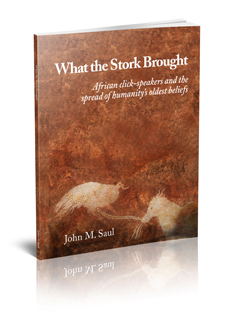 |
| Books | About the Author | Contact | Links | My cart |
John M. SAUL WHAT THE STORK BROUGHT Every year as the seasons turned, the birds would depart heavenward, but then mysteriously return, seemingly young again. Could Earthbound humans to do the same? With this question, the human adventure began. No way was found to follow the birds but the haunting question endured and in time our ancestors would replace storks and other birds by “Eland”, starry counterpart of the greatest of the African antelopes. For at the beginning of spring, the time of year when all is reborn, Eland would walk up the Milky Way to the abode of the Hereafter. Though unable to fly with Stork, humans might nevertheless follow the tracks of Eland, or so it was hoped. Related beliefs have been shared since earliest prehistory. The sharing of these beliefs and their accompanying hopes is what makes us human. Reconstruction of our most distant past became possible by joining accounts given by Bushman (San) who lived in far southern Africa during the 19th century with information from present-day Hadza hunter-gatherers living in northern Tanzania just south of the Equator. The Bushman and the Hadza have been separated from one another for tens of thousands of years and the genetic difference between them is apparently the greatest among any pair of human populations anywhere. Their separation may be the earliest among surviving human groups. Yet their most deeply held beliefs are the same. Humans have a single biological heritage. It now appears that we also have a single cultural heritage. (More) April 2019 - 109 pages |
